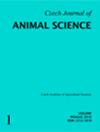两个猪品种早期空肠微生物群多样性的比较
IF 1.4
4区 农林科学
Q3 AGRICULTURE, DAIRY & ANIMAL SCIENCE
引用次数: 1
摘要
猪肠道微生物群在宿主的生命周期中发挥多种生理功能。宿主遗传学被认为是形成肠道微生物群的主要因素。本研究探讨了大河(DH)和滇南小耳猪(DS)这两个具有不同生长特性的重要中国本土品种的空肠微生物多样性和潜在的功能差异。每个品种(DH和DS)的9头仔猪饲喂母猪奶直到35日龄。收集空肠食糜样本进行16S rRNA测序。DH仔猪的出生体重、第35天的最终体重和平均日增重往往比DS仔猪增加更多。DH仔猪的肠道微生物Shannon指数也高于DS仔猪(P<0.05)。在属水平上,DH猪的XI梭菌、感觉狭窄梭菌、Turicibacter、Megasphaera、Veillonella、Mitsuokella和Selenomonas的相对丰度高于DS个体,线性判别效应大小分析显示DH和DS仔猪之间存在25个不同的细菌类群。Spearman的分析发现,肠球菌与最终体重(P=0.025,r=-0.56)和平均日增重(P=0.034,r=-0.53)呈负相关,平均日增重与梭菌XI(P=0.01,r=0.63)和Mitsuokella(P=0.007,r=0.62)呈正相关。我们的研究结果表明,DH猪具有较高的微生物多样性,而DS猪可能具有较高的脂肪沉积能力。本文章由计算机程序翻译,如有差异,请以英文原文为准。
Comparison of early-life jejunal microbiota diversity in two pig breeds
The pig intestinal microbiota perform multiple physiological functions during the lifespan of the host. Host genetics is considered a major factor shaping the intestinal microbiota. This study explored the jejunal microbial diversity and potential functional differences between Dahe (DH) and Diannan small-ear (DS) pigs, two important native Chinese breeds with different growth characteristics. Nine piglets of each breed (DH and DS) were fed sow milk until the age of 35 days. Jejunal chyme samples were collected for 16S rRNA sequencing. The birth weight, final body weight at day 35, and average daily gain tended to increase more in DH piglets than in DS piglets. The jejunal microbial Shannon index was also higher in DH piglets than in DS piglets (P < 0.05). At the genus level, the relative abundances of Clostridium XI, Clostridium sensu stricto, Turicibacter, Megasphaera, Veillonella, Mitsuokella, and Selenomonas in DH pigs were higher than those in DS individuals, whereas Streptophyta, Enterococcus, Lactococcus, and Weissella were lower in DH pigs than in DS pigs (P < 0.05). Furthermore, linear discriminant effect size analyses revealed 25 differential bacterial taxa between DH and DS piglets. Spearman’s analysis found that Enterococcus was negatively correlated with final body weight (P = 0.025, r = –0.56) and average daily gain (P = 0.034, r = –0.53), while average daily gain was positively correlated with Clostridium XI (P = 0.01, r = 0.63) and Mitsuokella (P =0.007, r = 0.64). Kyoto Encyclopedia of Genes and Genomes annotation identified eight functional categories related to amino acids and energy metabolism in DH piglets, while three categories were related to lipid metabolism in DS piglets. Our findings suggest that DH pigs have higher microbial diversity, while DS pigs may have higher fat deposition ability.
求助全文
通过发布文献求助,成功后即可免费获取论文全文。
去求助
来源期刊

Czech Journal of Animal Science
Agriculture, Dairy & Animal Science-奶制品与动物科学
CiteScore
2.40
自引率
16.70%
发文量
44
审稿时长
5 months
期刊介绍:
Original scientific papers and critical reviews covering all areas of genetics and breeding, physiology, reproduction, nutrition and feeds, technology, ethology and economics of cattle, pig, sheep, goat, poultry, fish and other farm animal management. Papers are published in English.
 求助内容:
求助内容: 应助结果提醒方式:
应助结果提醒方式:


